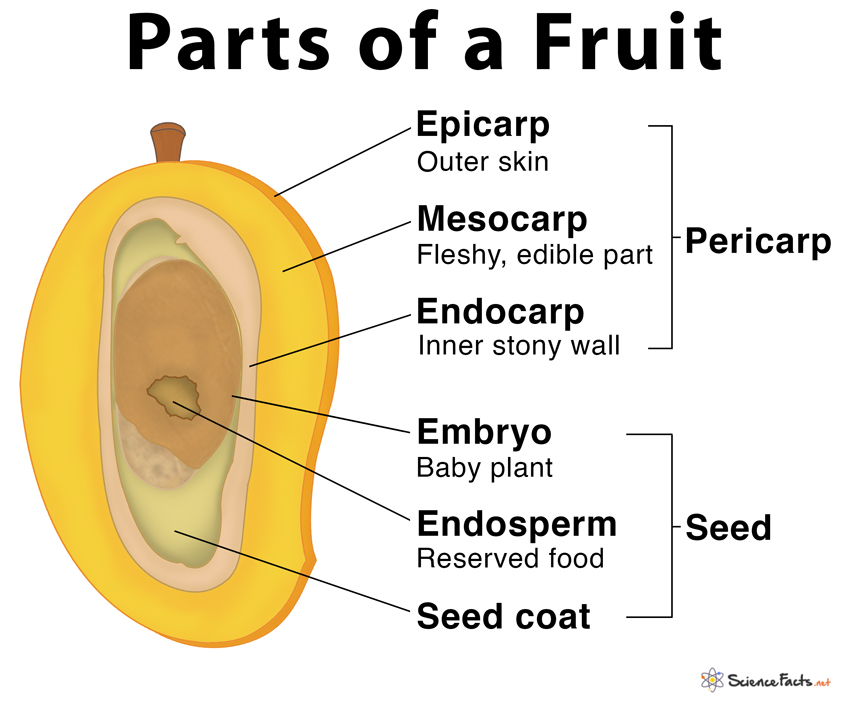Fruits are an essential source of vitamins, minerals, and fibers and are thus considered natural medicines. They are also an essential source of a balanced diet. Some fruits contain seeds within them, while others are seedless.
Which Part of a Plant Can Grow into a Fruit?
What are the Different Parts of a Fruit with Functions?
Types of Fruits
Importance of Fruits
1) Pericarp
It is the edible part of the fruit formed from the wall of the ripened ovary. The pericarp may be fleshy as in apple, mango, and guava or dry as in walnut and apricot. It is further divided into three parts: a) Epicarp: Also known as exocarp, it is the outermost layer of the pericarp that forms the tough, outer skin of the fruit. It protects the inner parts of the fruit from damage. In citrus fruits, the epicarp layer is called flavedo. b) Mesocarp: It is the middle layer of the pericarp. It is the fleshy, edible part of the fruit found in apples, mangoes, and peaches. In citrus fruits, the white mesocarp layer after the flavedo is called albedo. c) Endocarp: It forms the innermost layer of the pericarp that immediately surrounds the seed. It protects the seed from damage. The endocarp is generally not consumed, but in citrus fruits like oranges, they form the central juicy, edible part.
2) Seed
They are structures that enclose the developing embryo of a plant. Seeds are the ripened, fertilized ovules consisting of three parts: a) Seed Coat: It is the protective outer covering of the seed. It further consists of two layers, the thick outer testa and the delicate inner tegmen. The seed coat protects the seed from mechanical damage. b) Endosperm: Found below the seed coat, it is rich in starch and proteins that act as reserve foods for the developing embryo. c) Embryo: It is the developing plant with underdeveloped tissues like stems and roots. They are further divided into four parts: epicotyl, hypocotyl, radical, and cotyledons. The embryo later gives rise to a new plant.
1) Simple Fruits
These fruits arise from a single matured ovary in a single flower. Simple fruits are further divided into two types: dry fruits and fleshy fruits.
Dry Fruits
In these fruits, the entire pericarp becomes dry once the fruits mature. Dry fruits are of two types: dehiscent and indehiscent. a) Dehiscent dry fruits: These fruits split open when they become mature. They are of the following types:
Follicle: Composed of a single carpal and splits only along one suture after maturing. Example: Larkspur
Legume: Composed of a single carpal and spits along its dorsal and ventral sutures after maturing. Example: Pea
Capsule: Consists of multiple carpals that open at maturity. Example: Eucalyptus
Silique: Consists of two carpals that open at maturity. Example: Mustard
b) Indehiscent Dry Fruits: These fruits do not split open when they become mature. They are of the following types:
Akene: The seed is attached to the fruit at a single point. Example: Sunflower
Caryopsis: The seed is attached to the fruit at all possible points. Example: Maize
Samara: One or two-seeded having seeds that are wing-shaped. Example: Maple
Schizocarp: Consists of multiple carpals that separate when they become mature to form multiple indehiscent fruits. Example: Dill
Nut: Contains thick, hard pericarp and is a one-seeded fruit formed from a single ovary. Example: Chestnut
Loment: Have several seeds. They break into a single-seeded segment upon maturation. Example: Crown vetch
Fleshy Fruits
In these fruits, the pericarp develops into thick, fleshy tissues. Fleshy fruits are of the following types: a) Berry: Derived from one or more carpals and contain one or more seeds. Here, the pericarp is soft, fleshy, and juicy. Example: Banana The berry is modified into the following types:
Pepo: A hard and thick rind with a tough outer skin. Example: WatermelonHesperidium: A leathery rind with partitions between the sections. Example: OrangeBalausta: An outer hard rind made of epicarp and a part of mesocarp. Example: Pomegranate
Apart from the above three types of modified berry, there is another less common modified type called Amphisarca. b) Drupe: Also known as stone fruit, it is derived from a single carpal and contains a single seed. The exocarp is present as thin skin, the mesocarp is fleshy, and the endocarp becomes stony hard. Example: Mango c) Pome: Also called an accessory fruit, it is formed by a group of carpels that remain united with the help of a receptacle. Example: Apple
2) Aggregate Fruits
These fruits develop from multiple, matured ovaries in a single flower. In other words, an aggregate fruit is made of multiple simple fruits called ‘fruitlets.’ Examples: Strawberry, blackberry, and raspberry
3) Multiple Fruits
Also known as composite fruits or false fruits, these are single big fruit formed together by all the flowers in an inflorescence. Multiple fruits are of two types: sorosis and syconus.
Sorosis
They grow from catkin, padix, and spikes type of inflorescence. Example: Pineapple
Syconus
They grow from hypanthodium type of inflorescence. Example: Figs
Keep us hydrated since most of them are rich in water content.Act as a rich source of vitamins and minerals essential for the body’s growth and development and help keep our bones and muscles tougher.Provide a high source of dietary fiber that helps to reduce blood cholesterol levels, forming healthy bowels, and preventing constipationAct as antioxidants, thus prevent cancer and reduce the process of aging.
